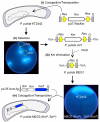A GFP-lacZ bicistronic reporter system for promoter analysis in environmental gram-negative bacteria
- PMID: 22493710
- PMCID: PMC3321037
- DOI: 10.1371/journal.pone.0034675
A GFP-lacZ bicistronic reporter system for promoter analysis in environmental gram-negative bacteria
Abstract
Here, we describe a bicistronic reporter system for the analysis of promoter activity in a variety of gram-negative bacteria at both the population and single-cell levels. This synthetic genetic tool utilizes an artificial operon comprising the gfp and lacZ genes that are assembled in a suicide vector, which is integrated at specific sites within the chromosome of the target bacterium, thereby creating a monocopy reporter system. This tool was instrumental for the complete in vivo characterization of two promoters, Pb and Pc, that drive the expression of the benzoate and catechol degradation pathways, respectively, of the soil bacterium Pseudomonas putida KT2440. The parameterization of these promoters in a population (using β-galactosidase assays) and in single cells (using flow cytometry) was necessary to examine the basic numerical features of these systems, such as the basal and maximal levels and the induction kinetics in response to an inducer (benzoate). Remarkably, GFP afforded a view of the process at a much higher resolution compared with standard lacZ tests; changes in fluorescence faithfully reflected variations in the transcriptional regimes of individual bacteria. The broad host range of the vector/reporter platform is an asset for the characterization of promoters in different bacteria, thereby expanding the diversity of genomic chasses amenable to Synthetic Biology methods.
Conflict of interest statement
Figures






Similar articles
-
Chromosomal integration of transcriptional fusions.Methods Mol Biol. 2014;1149:479-89. doi: 10.1007/978-1-4939-0473-0_37. Methods Mol Biol. 2014. PMID: 24818927
-
A simple system for converting lacZ to gfp reporter fusions in diverse bacteria.Gene. 2006 May 10;372:219-26. doi: 10.1016/j.gene.2006.01.004. Epub 2006 Feb 24. Gene. 2006. PMID: 16500039
-
Early and late responses of TOL promoters to pathway inducers: identification of postexponential promoters in Pseudomonas putida with lacZ-tet bicistronic reporters.J Bacteriol. 1993 Nov;175(21):6902-7. doi: 10.1128/jb.175.21.6902-6907.1993. J Bacteriol. 1993. PMID: 8226632 Free PMC article.
-
Development of a synthetic cumate-inducible gene expression system for Bacillus.Appl Microbiol Biotechnol. 2019 Jan;103(1):303-313. doi: 10.1007/s00253-018-9485-4. Epub 2018 Nov 3. Appl Microbiol Biotechnol. 2019. PMID: 30392122
-
Inducible and tunable gene expression systems for Pseudomonas putida KT2440.Sci Rep. 2021 Sep 10;11(1):18079. doi: 10.1038/s41598-021-97550-7. Sci Rep. 2021. PMID: 34508142 Free PMC article.
Cited by
-
Detection of Bioavailable Cadmium by Double-Color Fluorescence Based on a Dual-Sensing Bioreporter System.Front Microbiol. 2021 Sep 16;12:696195. doi: 10.3389/fmicb.2021.696195. eCollection 2021. Front Microbiol. 2021. PMID: 34603225 Free PMC article.
-
Quantitative, non-disruptive monitoring of transcription in single cells with a broad-host range GFP-luxCDABE dual reporter system.PLoS One. 2012;7(12):e52000. doi: 10.1371/journal.pone.0052000. Epub 2012 Dec 28. PLoS One. 2012. PMID: 23284849 Free PMC article.
-
Construction of a RFP-lacZα bicistronic reporter system and its application in lead biosensing.PLoS One. 2020 Jan 30;15(1):e0228456. doi: 10.1371/journal.pone.0228456. eCollection 2020. PLoS One. 2020. PMID: 31999769 Free PMC article.
-
A Microbial Cocaine Bioreporter.Sensors (Basel). 2024 Oct 11;24(20):6549. doi: 10.3390/s24206549. Sensors (Basel). 2024. PMID: 39460031 Free PMC article.
-
Shedding light on Klebsiella pneumoniae virulence: Engineering of broad host range bioluminescence reporter vectors for transcriptional analysis in drug resistant pathogens.Plasmid. 2024 Sep-Nov;131-132:102734. doi: 10.1016/j.plasmid.2024.102734. Epub 2024 Oct 29. Plasmid. 2024. PMID: 39481464 Free PMC article.
References
-
- Teichmann SA, Babu MM. Gene regulatory network growth by duplication. Nat Genet. 2004;36:492–496. - PubMed
-
- Martinez-Antonio A, Collado-Vides J. Identifying global regulators in transcriptional regulatory networks in bacteria. Curr Opin Microbiol. 2003;6:482–489. - PubMed
-
- Thieffry D, Huerta AM, Perez-Rueda E, Collado-Vides J. From specific gene regulation to genomic networks: a global analysis of transcriptional regulation in Escherichia coli. . Bioessays. 1998;20:433–440. - PubMed
Publication types
MeSH terms
Substances
LinkOut - more resources
Full Text Sources

